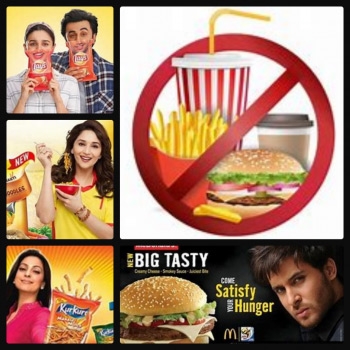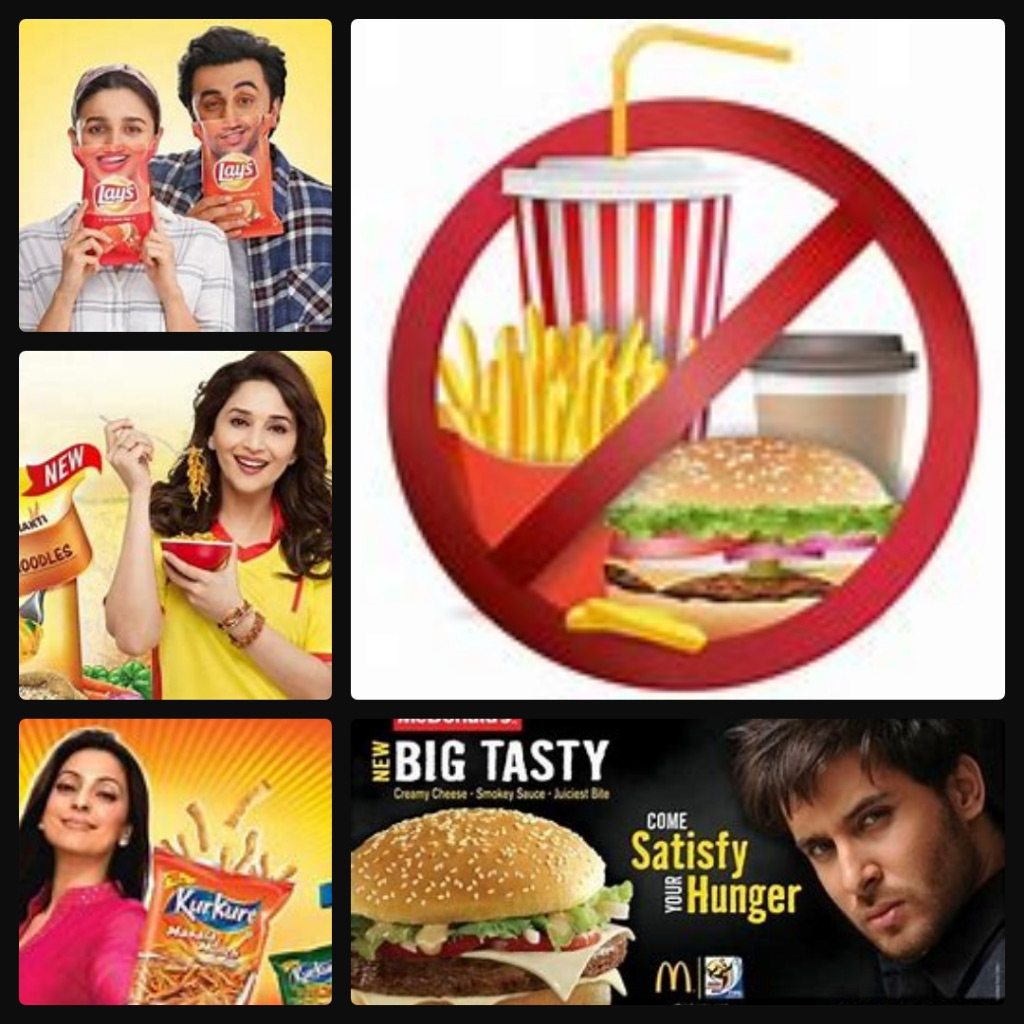
.png) Aarti
Aarti

The Union Ministry for Women and Child Development's proposal to ban airing of advertisements promoting junk food and carbonated drinks during children’s programmes on television is yet another small step on the long road in the fight against unhealthy food.
The fact of the matter is that junk foods have come to stay across the globe and India is no exception. Thanks to the marketing might of many powerful brands coupled with changing consumption patterns of masses, sugary to heavily processed foodstuffs - be it chips, cookies, pizzas, burgers or rolls etc., - are not only easily available but competitively priced. Literally for the addicts, it may not take more than a few moments to order such food through their smartphones in the comfort of their homes. They are door delivered across our cities and suburbs in a jiffy.
It took almost 12 years after the Delhi-based NGO, Uday Foundation filed a PIL in the Delhi High Court in 2010 to ban junk food and carbonated drinks in schools besides ensure children have nutritious school lunches and breakfasts every day. Ultimately, efforts to ban junk food got a fillip with the enactment of the Food Safety and Standards (safe food and balanced diets for children in school) Regulations, 2020. Enforced from July 1, 2021, food products high in saturated fat or transfat or added sugar or sodium have been banned in the school, hostel, etc. In terms of the said regulations, foods which are referred to as food products high in saturated fat or transfat or added sugar or sodium (HFSS) cannot be sold to school children in school canteens/mess premises/hostel kitchens or in an area within fifty meters from the school gate in any direction. Also, food business operators manufacturing HFSS foods have been barred from advertising and marketing of such foods to children in school premises including through logos, brand names, posters, textbook covers etc. or in an area within fifty meters from the school gate in any direction. The school authority should ensure that a board containing warning "Do not sell (including free sale or market or advertise) the food products high in saturated fat or transfat or added sugar or sodium within school premises or campus" in English or one Indian language, as applicable, is displayed prominently at the entrance gate or gates of the school.
Whether such a move is a form of censorship? Do such advertisements actually influence children's food preferences, cause an increase in the number of child consumers or have no role to play in creating demand for such products?
Undoubtedly, fast food may be appealing, convenient to procure and tickle one’s taste buds but regular consumption of unhealthy/processed food (junk food) has been found to be contributing towards the development of obesity. To make fast foods attractive, tasty, beside enhance shelf life, a host of chemicals that are used not only compromises the nutritional quality of such food but are harmful to human health. Notably, both sugar and fat in excessive quantities has been found to evoke brain chemicals called beta-endorphin and dopamine (which are also activated by narcotics like heroin and cocaine). In other words, when fat and sugar are put together, the ‘potentiated effect’ takes place - that is, a bigger brain response.
Studies at Harvard School of Public Health found that transfats (created by converting liquid oils to solids by adding hydrogen) has caused about 50,000 premature heart-attack deaths annually, making partially hydrogenated oil one of the most harmful ingredients in the food supply. Some years back, after tests showed that monosodium glutamate, a flavour enhancer used in meats, condiments and soups caused brain damage in lab animals, baby-food manufacturers in developed countries removed it from their products.
Affecting people of all ages from all social groups, both in developed and developing countries, obesity rates have nearly tripled since 1975. Significantly, in children and adolescents, it has increased almost five times. With a whopping 380 million children and adolescents affected by obesity worldwide, the alarm bells are ringing. As such, overweight and obesity rates in children and adolescents in India are increasing not just among the higher socio-economic groups but also in the lower income groups where underweight still remains a major concern. The pooled data after 2010 estimated a combined prevalence of 19.3 percent of childhood overweight and obesity which witnessed a significant increase from the earlier prevalence of 16.3 per cent reported in 2001- 2005 is surely a cause for serious concern. Childhood obesity has been found to trigger the prediabetic condition. With many of our cities reporting a rise in prediabetic cases by about 20 percent among adolescents (aged 15 to 18), if the current trends persist, India is likely to contribute 11 per cent of the global burden of child obesity by 2030.
Several studies have concluded that children who are overweight or obese are at a higher risk of developing serious health problems, including type 2 diabetes, high blood pressure, asthma, other respiratory problems, sleep disorders and liver disease. They may also suffer from psychological effects, such as low self-esteem, depression and social isolation.
Beyond debates and controversies, children’s exposure to television food advertising, evidently, as studies have shown, influences towards strong brand attachments. Consequently, a major factor that contributes to childhood obesity is recurrent exposure to unhealthy food marketing.
Is there a way out?
Interestingly, the manner in which Chile dealt the junk food menace with a heavy hand merits emulation. Alarmed that nearly 49 per cent of its preschool children were overweight, Chile, instituted a nationwide initiative five years back to regulate the manner in which junk food was marketed. Besides banning fun cartoon characters on cereal boxes and certain foods from being served in schools, new labels indicating which products were high in sugar, calories or saturated fat were placed on the front side of many beverages and snacks. 18 months after the new food law went into effect, sales of sugar-sweetened drinks dropped a whopping 25 per cent whereas sales of diet soda, bottled water and fruit juices containing no added sugars rose 5 per cent. Similarly, in 2018, Chile banned TV advertisements of any junk foods exceeding nutritional thresholds from 6 a.m. to 10 p.m. It emerged that pre-schoolers’ exposure to child-targeted advertising of unhealthy foods decreased considerably and were more pronounced for children who watched more television.
While there is an imperative need for regular policy interventions at the macro level to regulate unhealthy foods, each one of us need to decide before purchasing processed, canned and fast foods. Media reports indicate that the Food Safety and Standards Authority of India has plans to introduce a health star rating system for packaged food. The number of stars displayed on the front of the pack will indicate how healthy or unhealthy it is, depending upon the amount of salt, sugar and fat. However, health activists have submitted that along with the health star rating, the average consumer also needs to be informed if the items in the product contain sugar, salt, or saturated fats beyond a threshold limit to facilitate them make informed decisions about their purchases.
Food is addictive and at times it becomes nearly impossible to resist, nonetheless, being mindful about one’s eating habits not only keeps us fit but also boosts our immunity. It pays to particularly read, understand the food labels so that one knows what is in such products.
Let's forget celebrities endorsing brands.
Our health is in our hands.